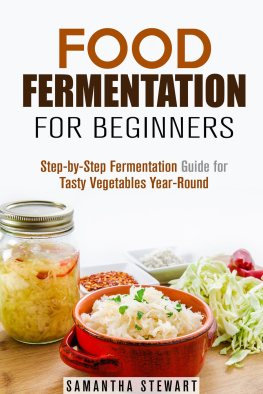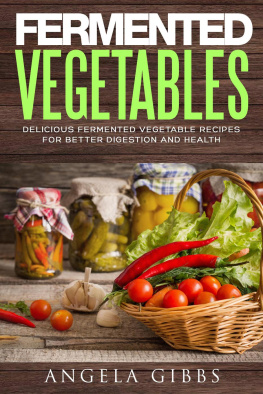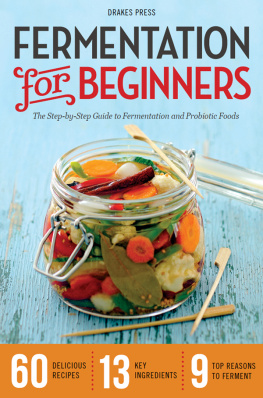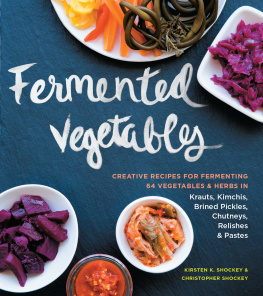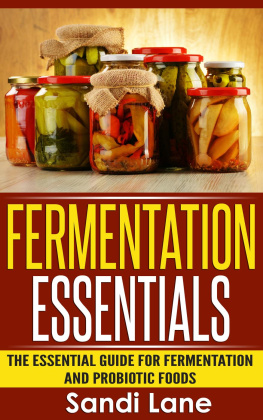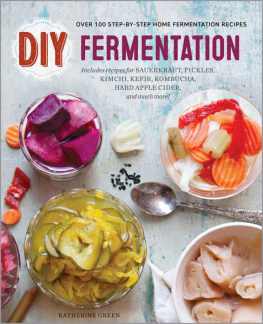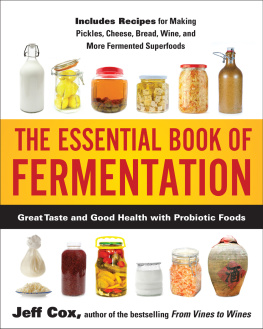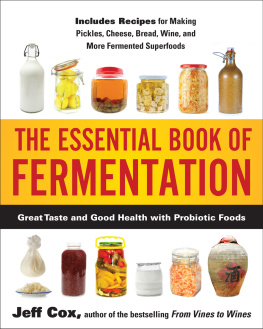Food Fermentation for Beginners
Step-by-Step Fermentation Guide for Tasty Vegetables Year-Round
Copyright Notice
Reproduction, duplication, transmission of this document in part or in whole is permitted only with written permission from the publisher. All rights reserved.
Respective brands and trademarks mentioned in this book belong to their respective owners.
Disclaimer
This document is geared towards providing summarization of information related to the topic. While all attempts have been made to verify the accuracy of the information, the author does not assume any responsibility for errors, omissions, or interpretations of the content. The information is offered for informational or entertainment purposes only. If professional advice is necessary, a qualified legal, medical, financial or another respective professional should be consulted. The reader is responsible for his or her own actions. The publisher does not accept any responsibility or liability arising from damages or losses, real or perceived, direct or indirect, resulting from the use of this information.
Table of Contents
Introduction
W hether you have made a personal or family decision to improve your health, or you are just an avid cook looking for new types of food to serve your household learning how to ferment vegetables on your kitchen countertop may be your solution to both searches.
Do you love going to the Farmers Market, with all the colorful seasonal vegetables and produce? Have you started a kitchen garden of favorite vegetables and herbs? If you're like many people, you wish you could have all of this colorful and tasty range of vegetables and fruits year-round not just when harvest time is here.
You can join what millions of people over human history have done to fulfill that wish: you can ferment your own foods at home. Fermenting vegetables in particular in your own kitchen is easy to do, requires very little equipment, and here's the best part it doesn't require any cooking.
Think of your grandmothers refrigerator pickles. Those refrigerator pickles are an example of a simple fermented food. You are not quite sure whether they are raw or not, because they taste like they are just out of the garden. They are crunchy, a bit sour and a bit salty. And although your grandmother probably never told you this they only took about three or four days to make, right on her countertop!
Think of sauerkraut, which is a staple not only in Europe, but in North America. It is also a fairly simple fermented food. It requires no cooking just freshly harvested cabbage and two other simple ingredients.
You don't need to understand anything about food science to succeed at fermenting your garden fresh vegetables. You don't need to be a master chef to give your jars of fermented vegetables a variety of flavors that come from your choice of spices and herbs added to your jars.
Fermenting vegetables requires only some glass jars, sea salt, filtered water and freshly harvested seasonal vegetables. You'll have to do a bit of slicing, grating or shredding and a chopping knife is just perfect (you can use a food processor if you wish, naturally!).
You'll have to have a bit of counter space for a few days when you do your fermenting. And then, you will have to have some refrigerator space or other appropriate cold storage once the fermentation process is complete. Storing your fermented vegetables in a cold place stops and holds the fermentation process.
That's it! Beyond this, learning how to ferment vegetables with success in your own kitchen is a matter of experimentation and personal taste preferences.
You don't need to ferment your cabbage "all the way" to sauerkraut to enjoy the benefits of fermented food.
Benefits? Yes! By doing what the scientists call lacto-fermentation, you can provide to your gut your entire digestive tract, in other words all the good, healthy bacteria that it may be lacking right now without you even knowing it.
The best physicians of all ages have known that health starts in the gut. Digestive health is imperative for us, because that's largely where the immune system resides. A strong immune system maintains our good health. A strong immune system helps us balance back if we should be a little under the weather or fighting any sort of infection.
When you have a "healthy gut", you have good overall health. Fermented foods help you maintain that healthy gut.
When you go to a Functional Physician, or to a Naturopathic Physician or a Nutritionist, the first thing they will do in their exam is to determine what youre eating and whether what you are eating is creating or preventing health.
Create and maintain good gut health all on your own. Eat more home-fermented vegetables! Our topic here, of course, is just fermented vegetables but don't forget other fermented foods which are popular around the globe.
These are also some other foods that you can make right in your own kitchen if you wish to get creative:
- You can make probiotic-rich yogurt from the whole milk right in your own kitchen.
- If you have olive trees in your garden or in your region, you can ferment ripe olives right off the tree in big pots on your back patio.
- Ever eaten thin slices of dry sausage? That's a fermented meat!
- Ever had Bacalhau a Bras in a Portuguese restaurant? The codfish was fermented.
- All alcoholic beverages depend on fermentation. Beer, wine and stronger spirits? All from fermented fruit or grain.
The best way to get accustomed to the fermentation of foods is to begin with your own garden vegetables, or vegetables from your local Farmers Market.
In this e-book will show you some easy ways to get started so that you can enjoy the bounty of summer and autumns vegetable harvests all year long.
Chapter 1: The Science of Fermentation and Lacto-Fermentation
W hat you will learn in this chapter:
- History of fermentation
- Lacto-fermentation and probiotics
- Types of fermented foods around the world
- Not all fermentation processes are equal when it comes to creating more healthful foods
Fermentation or zymology has been part of food processing for over 8,000 years. Why? There are really only 2 main reasons.
- It is a natural, easy and cost-free way to preserve bump-crops and to feed yourself between growing or hunting seasons!
- Everything you need to do it is available everywhere on the planet!
Most people remember that beer, wine and alcoholic beverages made from fruit or grains undergo fermentation. We have yeast bread due to the fermentation process. Sauerkraut and kimchi, fermented milk, cheeses and yogurts come to us because fermentation exists. Fish and meats undergo fermentation and are thusly preserved for our consumption during winter months.
The key to healthful fermentation (contrary to industrialized vinegar fermentation and pasteurization processes) is lacto-fermentation, or use of the lactobacillus bacteria. Lacto-fermentation is the primary type of fermentation producing natural probiotics in the resulting foods (youll see the role of salt in manufacturing probiotics right out of your fresh vegetables in a few pages).
Lacto makes us think of dairy products, but Lactobacillus bacteria are quite different. These bacteria do indeed use lactose, as well as other types of sugar, and convert these sugars to lactic acid. Historically, fermented foods have been around for millennia around the globe:
- East and Southeast Asia are known for natto (fermented soy; high in Vitamin K2), the fermented cabbage called kimchi, pickled vegetables, soy and fermented fish sauces and fermented shrimp paste
- Farming societies in central Africa are known for porridges made from soured (fermented) grains
Next page
